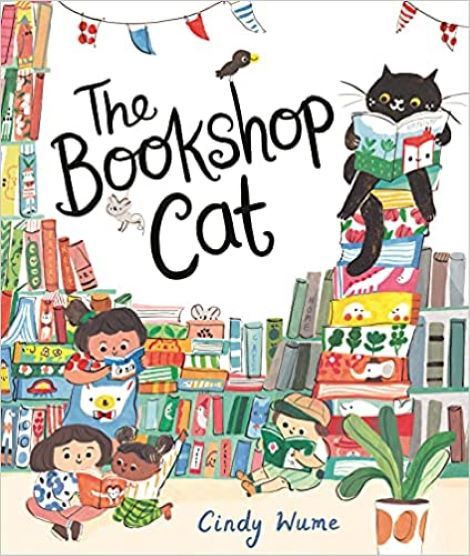Book Pitch: The Bookshop Cat by Cindy Wume
By Vera Hadzic
Cindy Wume’s picturebook The Bookshop Cat might be geared towards children, but its protagonist wrestles with a struggle all too familiar to students and adults: finding a job.
The protagonist is a cat whose family is filled with working cats—some are cooks, others are mechanics, still others are gardeners. They each attempt to recruit the protagonist into their profession, but he is committed to turning his passion for books into a job of his own. When he is hired as a helper at a local children’s bookstore, he discovers how important books and family can be for bringing a community together.
Why This Book Matters
With a book, you can go anywhere and be anything. (Wume)
This book really encapsulates the mission of the Windows and Mirrors project because it shows how literary windows can enrich the lives of young readers, while also exploring the community structures which must be put in place in order to get those windows into the hands of children.
I love that the bookshop in this story is specifically a children’s bookstore—it is designed as a safe place for young readers to step into new worlds. Through Wume’s evocative and abundant illustrations, we see children of many ethnicities coming to the bookstore to explore new worlds through books. This is one of those stories where diversity is not the focus of the story, but a diverse world is portrayed richly and dynamically through the illustrations. Diverse characters enliven the pages and support the story with their presence. These children are all welcome to read and play at the bookstore, bringing the power of childrehood with them and taking the magic of literature away. This emphasis on children's literature is a really valuable portrayal of how reading can enrich and shape young readers’ lives.
Disaster strikes for Bookshop Cat when the children’s bookshop is flooded and children stop coming to the store. With the love and support of his family, Bookshop Cat finds ways to get children reading again, such as hiding clues throughout the town to lead children back to the store. The flood and the solutions to it illustrate that it’s not enough for books—specifically for diverse books—to just exist. As our cataloguing project has shown, writing diverse books is only one part of a larger publishing industry, with each store only one part of a network of local bookstores. We see these networks of distribution reflected in The Bookshop Cat: although it's important that the bookshop exists, Bookshop Cat still needs community systems to get the books into readers' hands.
The Sustainability of a Small Town Bookshop
She typically draws inspiration from her observations of humanity, a sense of place, loving of nature and her own imagination for the book projects. ("About Cindy Wume")
Wume’s bio highlights how she draws inspiration from “a sense of place”. This is part of the magic which stitches The Bookshop Cat together: the small-town bookshop, the local children, and the family of cats are all closely united through the community they live in. The community itself is visible and thriving on every page, and we get a sense of not just its cultural richness, but also its sustainability. For example, Bookshop Cat takes the bus every day to get to the bookshop; when the bus isn’t running, he takes his bike. This emphasis on public transit is so important because it offers a window into how to organize sustainable communities focused around the people who live in them. Equally powerful is Wume’s depiction of nature. Leafy plants, colourful flowers, and green vines populate the illustrations. Plants are everywhere; the natural world is deliberately brought into the pages of the book and woven into the community itself.
This greenery comes from Wume’s own love of nature. According to her website, “Her little garden has around 30 pot plants now and she’s planning to expand it with more beautiful ones.”
The importance of educating future generations for an ecologically sustainable future cannot be underestimated. (Debbie Bradbery)
In her research on developing global citizenship in children through ecologically sustainable texts, Debbie Bradbery highlights the intersections between cultural inclusion and environmental sustainability. Centering marginalized voices can lead to more sustainable communities. The Bookshop Cat is so significant because it emphasizes these two ideas—how we reinforce cultural diversity in our communities, how making space for all our community members can also help us to respect the natural world we live in.
Our own community
- Read about the City of Ottawa's plan for a sustainable community
- Find more resources on sustainability
- Want to meet Ottawa's own bookshop cat? Visit Milo at Barely Bruised Books!
Purr along with the bookshop cat...
Watch this video for a read-aloud of The Bookshop Cat!
Video: “Storytime with Pauline.” YouTube, uploaded by On Fife, 10 November 2021,
The Bookshop Cat is a small picturebook, but it compellingly narrates the interconnectedness between literature, diversity, and sustainability. It shares with young readers ideas about how communities can be organized and it helps older readers reconsider what is really important.
Also, it’s a lot of fun! The Bookshop Cat is ultimately the heartwarming story of a cat who finds his place in his family and in his community by doing what he loves—all without having to write up a resume.
Sources
Bradbery, Debbie. “Bridges to Global Citizenship: Ecologically Sustainable Futures Utilising Children's Literature in Teacher Education.” Australian Journal of Environmental Education, vol. 29, no. 2, 2013, pp. 221–237., doi:10.1017/aee.2014.7.
“Storytime with Pauline.” YouTube, uploaded by On Fife, 10 November 2021, https://youtu.be/cUiLCBgehno.
Wume, Cindy. “About.” Cindy Wume, https://cindywume.com/About. Accessed 25 February 2022.

